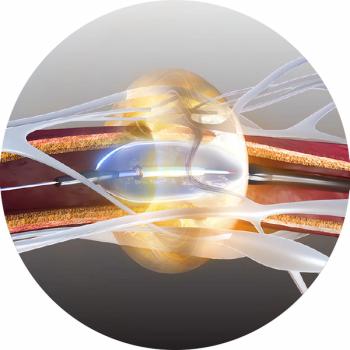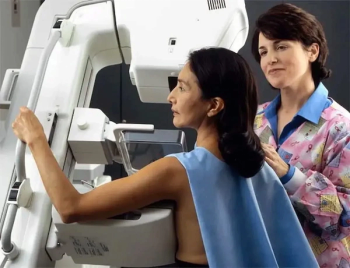
Introduction of 16-slice scanners nears, bringing promise of conebeam CT
Regulatory hurdles are behind the three major CT vendors, and the industry is moving nearly in lockstep to produce a commercial 16-slice capability in the coming months. The
Regulatory hurdles are behind the three major CT vendors, and the industry is moving nearly in lockstep to produce a commercial 16-slice capability in the coming months. The companies reported at the RSNA meeting FDA clearance of proprietary 16-slice technologies that will bolster speed and resolution by true volumetric reconstruction.
Siemens¹ Sensation 16, previously dubbed x32 because the detector would generate 32 slices per second, cleared reviewers just days before the 2001 meeting. GE also announced FDA clearance of its 16-slice LightSpeed detector. Marconi¹s Infinite Detector Technology had passed FDA muster in September. (The company was then absorbed by Philips, which inherited a leading role in the CT market segment by virtue of the newly rebranded Mx8000.) Toshiba America remains back in the pack, showcasing a work-in-progress 16-slice detector and a futuristic 256-slice detector that is years away from production.
This seemingly frenetic pace of developmentboth technological and corporateis actually more like a marathon than a sprint. Marconi, Philips, and Siemens have been leading customers on for more than a year with promises of 16-slice scanners. Only GE bolted, focusing instead at the 2000 RSNA meeting on an intermediate eight-slice scanner, which the company delivered earlier this year and touted at this year¹s meeting as the most advanced capability in hand. Some 158 units are already operating, executives said.
They may have a point. Although Philips, Siemens, and Toshiba highlighted their 16-slice technologies, no one is ready to begin shipping them. That will not happen until later in 2002.
GE Medical Systems
Company executives have hammered for years on their concept of an upgradable continuum of CT scanners. This year¹s swarm of 16-slice works-in-progress by competitors played into GE¹s hands.
- LightSpeed Ultra, an eight-slice version of the company¹s multislice CT, was GE¹s chosen highlight, even though this system was announced a year ago and 158 are in commercial operation. The availability of this system was the point, as GE executives cited competitors whose latest unveilings have been works-in-progress for two RSNA meetings running.
- A 16-slice version of LightSpeed cleared the FDA prior to the meeting.
- OptiDose sports several new dose-reducing features, including preloaded pediatric protocols that use color coding tied to a child¹s height and weight to ensure minimal x-ray exposure. SmartmA Enhanced, which will begin shipping around April 2002, uses a scout exam to tailor dose to variations in body thickness and shape. Other elements of OptiDose include artifact reduction algorithms to improve image quality at the lowest possible dose, as well as prospective ECG gating to help reduce dose during cardiac applications.
- Expanded clinical applications include CT colonography and Heart IQ, which provides several core cardiac applications such as assessment of the left ventricle and wall function. Lung nodule assessment, a capability that cleared the FDA just prior to the meeting, allows volumetric evaluation of suspicious lesions.
- The deal to acquire Imatron, maker of electron beam tomography scanners, appeared on track. The waiting period under the Hart-Scott-Rodino Antitrust Improvements Act of 1976 expired in mid-November.
Philips Medical Systems
Usually, companies upgrade equipment. It was the other way around for the Mx8000, which transformed Philips from a noncompetitor in the multislice segment to a world leader. In addition to technology, Philips gained critical engineering expertise and a strategic alliance with Siemens from its acquisition of Marconi Medical Systems.
- Mx8000 was shown in its 16-slice configuration. The heart of this product, Infinite Detector Technology (IDT), passed FDA review in September. The gantry has been upgraded to allow better than half-second rotation, thereby delivering 38 slices per second. An application-specific integrated circuit (ASIC) chip, called Tach, converts analog data coming off the detector to digital and then rapidly transfers the data to the computer.
- Images can be displayed on the MxView workstation or Philips¹ own EasyVision multimodality workstation.
- Clinical expansion possiblities with the 16-slice Mx8000 include volumetric lung and heart scanning, as well as soft plaque assessment and virtual endoscopy of the coronary vessels.
- Development has stopped on Philips¹ TrueView multislice detector, as attention shifts to how knowledge gained during this R&D effort might enhance the evolution of the Mx8000 and its IDT.
- Secura CT, a single-slice scanner introduced at the 2000 RSNA meeting, will likely be phased out. The scanner originally was positioned as a platform on which the Philips multislice detector would be mounted. With no such detector on the horizon and demand for single-slice scanners waning, this system has lost its place in the Philips product line.
Shimadzu Medical Systems
Value-oriented products have been characteristic of this company, which offers three distinct product lines: the high-performance SCT-7800T, midtier SCT-6800T, and low-tier SCT-4800T. All are single-slice scanners. Although Shimadzu has for several years integrated slip-ring technology into its more advanced models, the company has not yet developed a multislice detector.
- SCT-7800TC has been added as an entry-level product to the 7800T series. This new system introduces subsecond rotation using solid-state slip-ring technology and has many of the same features as more advanced members in the 7800T line-up.
- New software packages include Flex mA, which optimizes dose according to body area, based on a scout image taken just prior to the diagnostic scan. SynchroRECON features very fast reconstruction algorithms, delivering preview images in about 0.3 seconds.
Siemens Medical Systems
With the introduction of 16-slice scanning near at hand, the German company renamed its high-end multislice scanners the Sensation family. A quad-slice version will be offered alongside the Sensation 16. A dual-slice version of the midtier Emotion product, which was introduced at the 2000 RSNA meeting, offers a low-cost alternative. A step below is Balance, a one-second rotation, single-slice scanner that can be upgraded to a multislice Emotion configuration with 0.8 second rotational speed. The modular single-slice Smile is a low-end product offering a two-second gantry rotation.
- Sensation 16 represents the new top of Siemens¹ CT product line, delivering 16 slices with each 0.4-second rotation of the gantry. Real-time dose modulation matches the dose to the body site, depending on attenuation measured on the fly. The FDA cleared the system just prior to its introduction on the RSNA exhibit floor. Two systems are operating at clinical sites in Germany, and the first U.S. site is scheduled for installation in early 2002.
- Sensation Cardiac is a 16-slice scanner tailored for cardiovascular imaging. The product will be bundled with cardiac evaluation tools that allow calcium scoring and functional measurements, as well as cardiac visualization technologies such as VesselView, which is optimized for the coronary arteries.
- Sensation 4 is named for its quad-slice capability. It has been sold for three years under the name Somatom Plus 4 Volume Zoom.
- Advanced clinical applications for the quad- and 16-slice products center on coronary angiography, lung screening, and virtual colonoscopy.
- Version 4.0 software enhances the Sensation, Balance, and Emotion products, as well as niche products such as the low-end Esprit, which was introduced at the 2000 meeting of the European Congress of Radiology. The software includes dose-saving mechanisms, workflow improvements, and advanced clinical applications support such as real-time volume rendering.
Toshiba America Medical Systems
Japanese engineers continue to evolve Toshiba¹s multislice capability. Like most others in the industry, the company has chosen to leapfrog from quad- to 16-slice capability. Toshiba boasts the widest selection of multislice scanners, offering the premium performance quad-slice Aquilion and two quad-slice versions of its midtier Asteion product line. These two products, which can also be configured as single-slice scanners, differ primarily in the strength of their generators and x-ray tubes. The company also offers the low-cost single-slice Asteion VF 36.
- Asteion Multi 60 was highlighted this year in a multislice configuration. The main distinction between this unit and its sibling, Asteion Multi 48, is a more powerful generator (60 kW versus 48 kW). The single-slice version of the new system, called the Asteion VR 60, was shown as a work-in-progress at the 2000 RSNA meeting.
- The Quantum Detector series was shown in two new configurations: one delivers 16 slices, while the other renders 256 slices. The 16-slice version could be available by late 2002, but no time frame was given for the 256-slice version. Each slice in these works-in-progress will be 0.5-mm wide, with data gathered during half-second gantry rotations.
- Dose management technologies are integrated with the multislice detector. These include Real Exposure Control (EC), which automatically minimizes dose to the patient during the scan
Newsletter
Stay at the forefront of radiology with the Diagnostic Imaging newsletter, delivering the latest news, clinical insights, and imaging advancements for today’s radiologists.

































